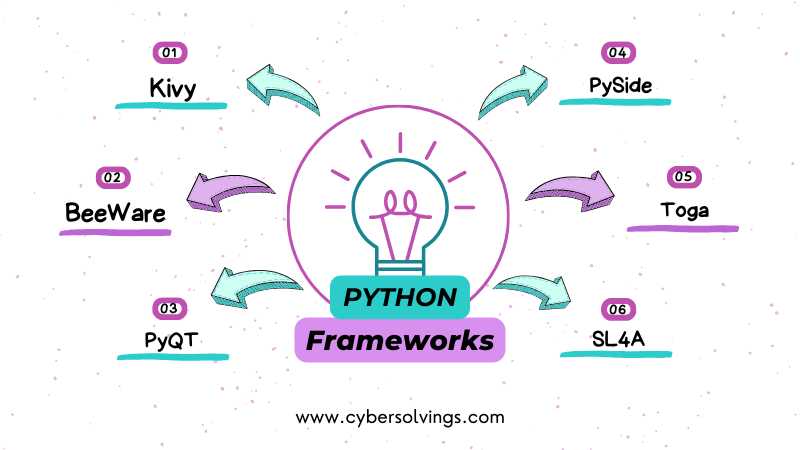Mobile app development has become a critical aspect of the tech industry, enabling businesses to reach a wider audience and provide enhanced user experiences. While languages like Swift and Java are traditionally used for mobile development, Python has emerged as a powerful alternative due to its simplicity and versatility. In this article, we'll explore the best Python frameworks for mobile development.
List of Python Frameworks for Mobile Development
Here is a complete list of best Python frameworks for mobile development.

1. Kivy
Overview of Kivy
Kivy is an open-source Python library that supports the development of multi-touch applications. It is particularly useful for rapid prototyping and creating applications that run on Android, iOS, Linux, macOS, and Windows.
Features of Kivy
- Cross-platform support: Write code once and deploy it across multiple platforms.
- Customizable UI: Offers a variety of widgets and layouts.
- Multi-touch support: Ideal for developing touch-based apps.
2. BeeWare
Overview of BeeWare
BeeWare is a collection of tools and libraries for building cross-platform applications in Python. It allows you to write apps in Python and deploy them on platforms like iOS, Android, Windows, macOS, and Linux.
Features of BeeWare
- Cross-platform support: Single codebase for multiple platforms.
- Native look and feel: Apps look and behave like native applications.
- Robust community support: Active development and community contributions.
Learn More at: https://cybersolvings.com/
3. PyQT
Overview of PyQT
PyQT is a set of Python bindings for Qt libraries that can be used to build cross-platform applications. It is known for its robust performance and wide range of features.
Features of PyQT
- Extensive documentation: Comprehensive guides and tutorials.
- Powerful widgets: Rich set of widgets for complex applications.
- Cross-platform support: Consistent behavior across different platforms.
4. PySide
Overview of PySide
PySide, also known as Qt for Python, is similar to PyQT but has a different licensing model. It is an official set of Python bindings for Qt libraries.
Features of PySide
- Cross-platform support: Supports Windows, macOS, Linux, and more.
- Comprehensive toolkit: Wide range of tools and libraries.
- Open-source: Free to use under LGPL.
5. Toga
Overview of Toga
Toga is a part of the BeeWare suite, specifically designed for building native applications using Python. It offers a native look and feel for applications on different platforms.
Features of Toga
- Cross-platform support: Works on iOS, Android, Windows, macOS, and Linux.
- Native widgets: Provides a native user interface.
- Part of BeeWare: Seamless integration with other BeeWare tools.
6. SL4A (Scripting Layer for Android)
Overview of SL4A
SL4A is a project that provides a bridge between Android and various scripting languages, including Python. It is useful for automating tasks on Android devices.
Features of SL4A
- Script execution: Run scripts directly on Android devices.
- Android integration: Access Android APIs using Python scripts.
- Ease of use: Simple setup and execution.
Learn More at: https://cybersolvings.com/
Pros and Cons of Using Python for Mobile Development
Advantages of Python Frameworks
- Ease of learning: Python’s simple syntax makes it accessible.
- Rapid development: Quick prototyping and development.
- Cross-platform: Develop once, deploy anywhere.
Limitations of Python Frameworks
- Performance: May not be as fast as native languages.
- Limited access to native features: Some frameworks might not support all native functionalities.
- Smaller community: Compared to mainstream mobile development languages.
Comparison of Python Frameworks for Mobile Development
Kivy vs. BeeWare
- Kivy: Better for touch-based applications and games.
- BeeWare: Better for creating native-looking applications.
PyQT vs. PySide
- PyQT: More mature with extensive documentation and a large community.
- PySide: Official bindings with a more permissive license.
Toga vs. SL4A
- Toga: Better for creating fully-fledged native applications across various platforms.
- SL4A: Ideal for scripting and automating tasks on Android devices.
Best Practices for Mobile Development with Python
Code Optimization Tips
- Use native modules wisely: Integrate Python with native modules for performance-critical tasks.
- Optimize algorithms: Ensure your code is efficient and avoid unnecessary computations.
- Memory management: Be mindful of memory usage to prevent leaks and crashes.
Learn More at: https://cybersolvings.com/
UI/UX Design Tips
- Consistent design: Maintain a consistent look and feel across different platforms.
- Responsive design: Ensure your app works well on different screen sizes and orientations.
- User feedback: Implement feedback mechanisms to enhance user experience.
Performance Improvement Strategies
- Profiling tools: Use profiling tools to identify and address performance bottlenecks.
- Asynchronous programming: Utilize asynchronous programming to handle tasks like I/O operations efficiently.
- Code refactoring: Regularly refactor your code to improve its structure and efficiency.
Conclusion
Python offers several robust frameworks for mobile development, each with its unique strengths and use cases. From Kivy's multi-touch capabilities to BeeWare's native look and feel, developers have a variety of tools at their disposal to create cross-platform applications. While Python may not always match the performance of native languages, its simplicity and versatility make it an excellent choice for many mobile development projects. As the ecosystem continues to evolve, the future looks promising for Python in the realm of mobile development.







